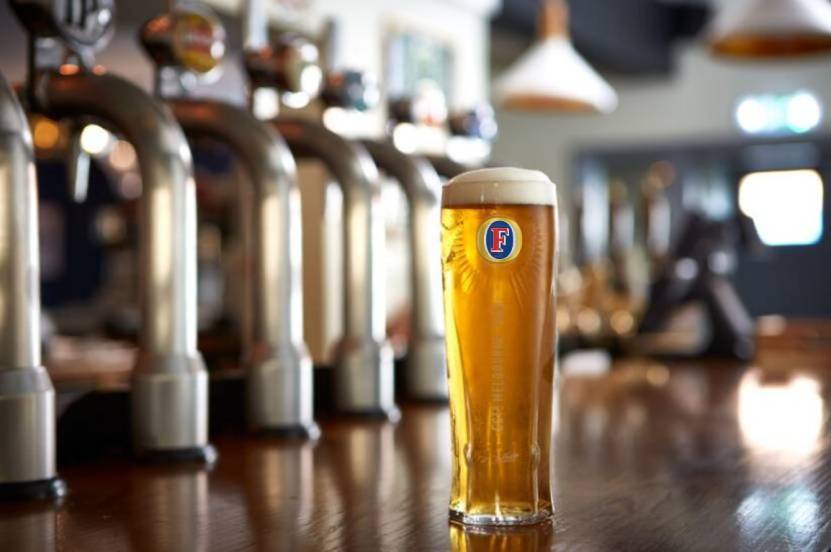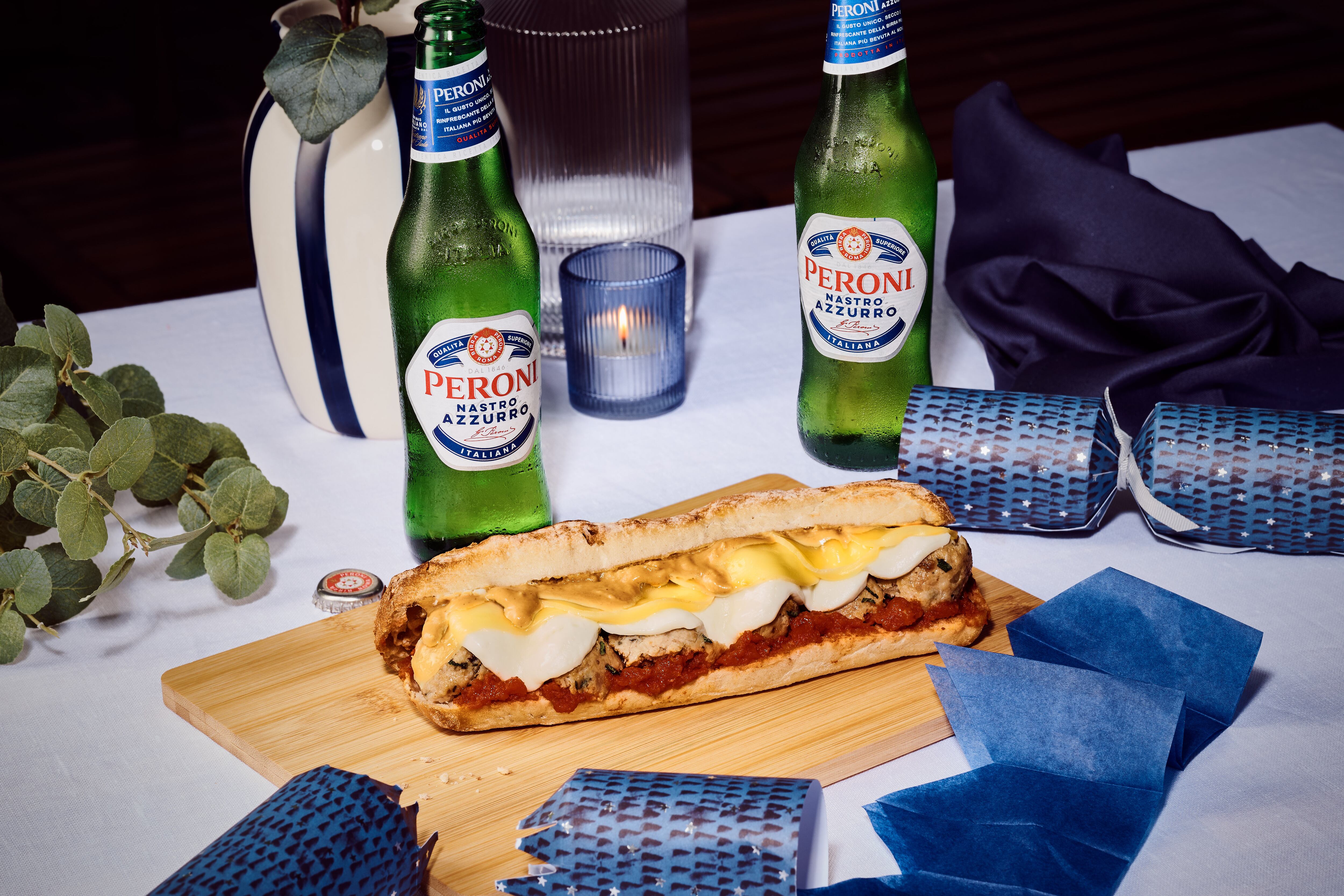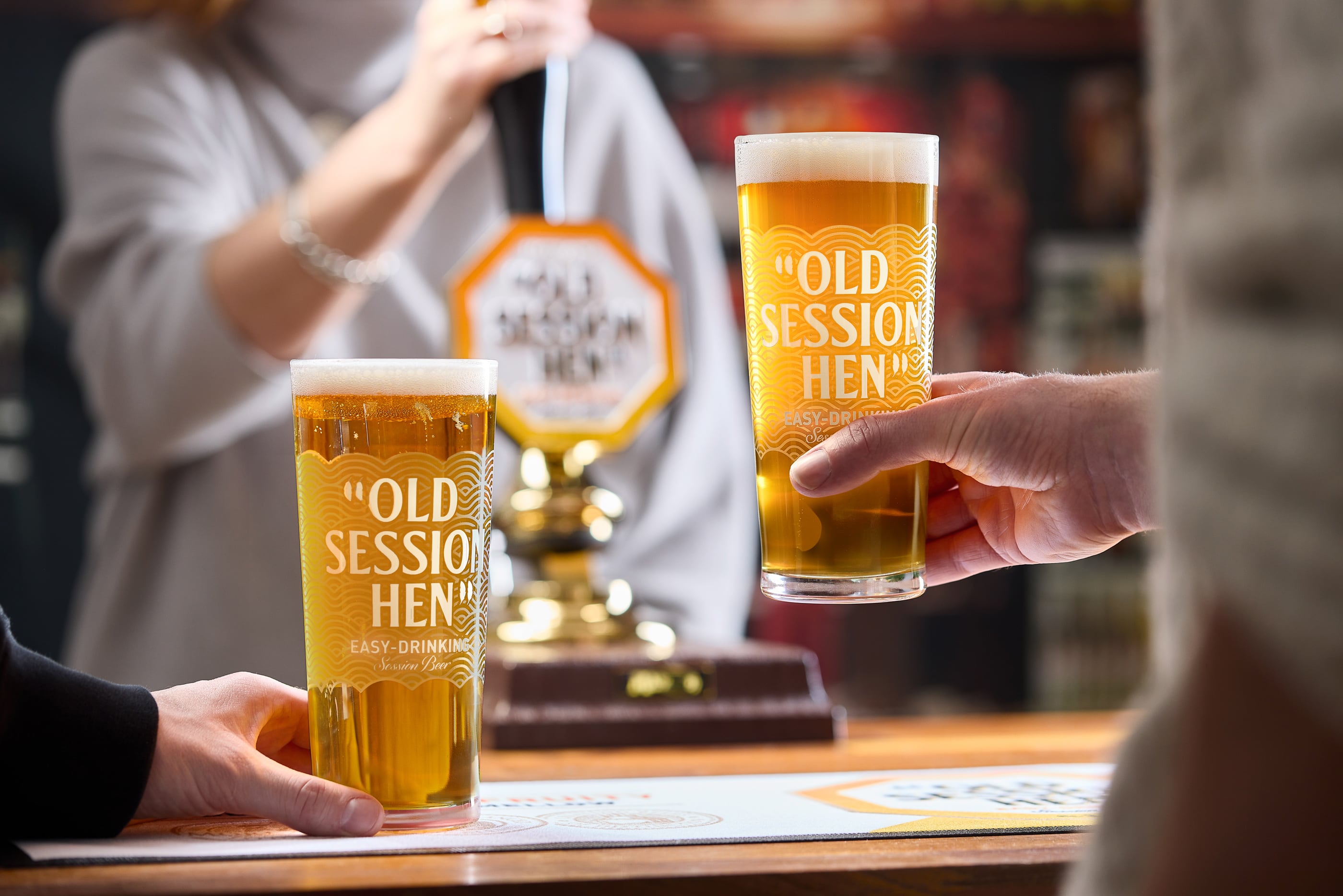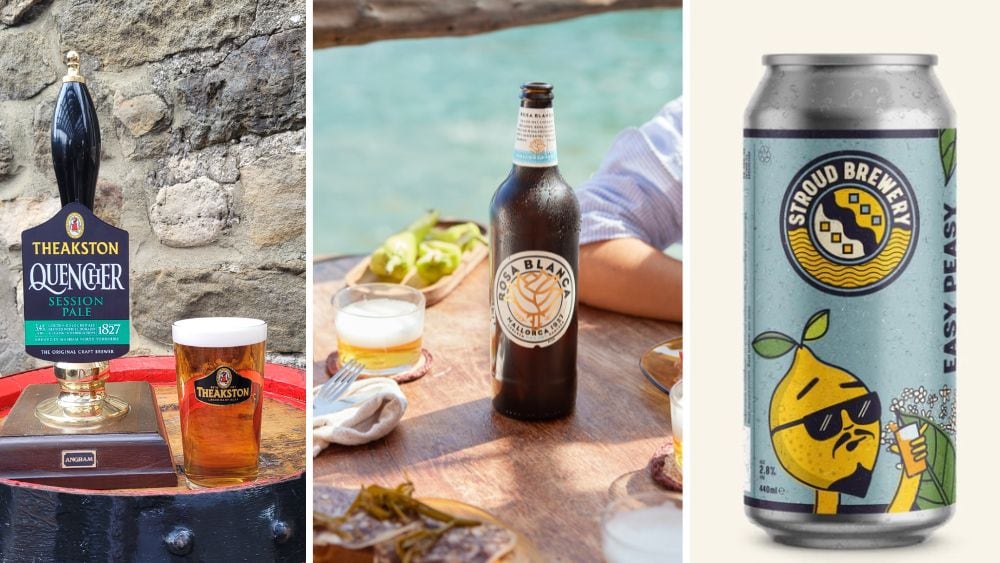The advantages are more than the obvious money saving factor. Here, some brewers tell The Morning Advertiser about their moves to take advantage of the legislation that was announced at the back end of 2021 but came into force in August 2023.
And there’s no lack of lower ABV beers across the market for consumers to take advantage of.
The most recent high-profile draught beer that will see its strength cut from 3.7% ABV to 3.4% ABV in February next year is Heineken UK-owned Foster’s. Foster’s was a 4% beer as recently as 2023.
One of the highest profile beers to see the cut in alcohol percentage was Carlsberg Pilsner in 2023, which the brewer said would also remove 56m units of alcohol from the UK drinks market.
Many beers have been cut in ABV, which you can read about here.
The duty reduction that was updated by the Government with new rates implemented in February 2025 means a brewer pays £8.28 per litre of pure alcohol on draught products under 3.5% ABV versus £18.76 on draught products between 3.5% and 8.5%.
As an example, if a brewer makes 5,000 hectolitres of beer at the lower ABV, it could save about £211,400 in duty.
Back to Heineken UK and its reduction of alcohol in its draught offering of Foster’s from 3.7% ABV to 3.4% ABV.
Heineken on-trade director Will Rice told The Morning Advertiser the duty saving would be used to ensure sales of Foster’s to its customers would be priced competitively.
Rice also said it already offers Satellite – a Beavertown session IPA – that has an ABV of 2.8%, which is available on draught.
Rice says of Foster’s: “You’ve got to make sure the quality is still there – there can’t be a trade-off. The new Foster’s has still got the same great, crisp, dry taste profile. Some consumers want lower ABV products and this of course takes alcohol units out of the market but it’s still got to be a great product.
“There’s value in it too so you can price it more competitively. We definitely want to have more competitive prices. There is a duty cliff there.
However, Rice said a beer should never be made with an alcoholic percentage below 3.5% ABV simply for the duty saving and said it must be done because the beverage is what consumers want, it’s the right proposition, has the right taste profile and offers good value.
“Foster’s is still a really strong seller and we really want it to remain competitive. We are going to invest in Foster’s and that’s a really important message to our customers. It’s a real strength in our portfolio that resonates really well with our consumers and our customers and we’ve invested in darts with it. It’s a fantastic product and can be a reason to go to the pub.”

Meanwhile, north-west brewer and pub operator Robinsons has cask beers Broken Record mild and Citra Pale Ale at 3.4% ABV and Robinsons Smooth and Dark Smooth at the same strength on keg.
Joint managing director Oliver Robinson says the business has never reduced the alcoholic strength of a beer for the single reason of saving money.
In fact, Robinson states one of the reasons would be so a customer can enjoy a “slightly more affordable pint” but he also says it is an act of helping with responsible drinking aspect and that could include ensuring a pint is available at a suitable strength if someone is driving.
“People are becoming more health conscious as well,” he explains, “so they do want lower strength. If you look at how many alcohol units we’ve taken out as an industry just by reducing ABVs, that is really important from a health point of view as well. I would say there’s no such thing as a good cigarette but actually there’s nothing wrong with a pint.”
He also argues in favour of a lower strength beer if a consumer is having more than one pint. “Is it more sensible to have more pints at a lower strength because you may feel a little better in the morning – and beer at a lower strength means you can continue drinking during the evening without drinking high-strength beers?”
He also feels [global brewers] are not doing anything differently to regional outfits.
Robinsons states: “We have a very close working relationship with lots of global brewers who feed into us and we’ve all got a similar view and opinion. If there’s a duty saving to be had, that’s great, but I don’t think that’s necessarily the driving force behind it. They’re seeing what we see and that is consumer habits starting to evolve and change, and they’re also feeding into it, just on a larger scale and that actually helps us.”
Remaining true to your values is important to Robinson too, who talks about Old Tom Ale, which is an 8.5% ABV barley wine that is more likely to be consumed as a wine rather than in pints.
“We make Old Tom Ale at 8.5% ABV – now that hits another duty threshold. We had a debate internally, which didn’t last very long, about whether or not we changed the ABV of that to 8% or 7.9% but we’ve been brewing Old Tom since 1 November 1899 to the original recipe.
“Anybody who’s drinking Old Tom isn’t worried about what they’re paying for it and what’s to say that threshold won’t change again to 7.5% or even 6.5% [in the future]. We will stick to our core values and keep it at 8.5%.”
He added Dizzy Blonde pale ale has an ABV of 3.8% but Robinsons is resolute it will not reduce the strength to meet the lower duty threshold because it has a great following.
“I’m not going to tweak the strength of Dizzy Blonde just to have another beer at 3.4%,” Robinson says.
We saw an opportunity to create a new product that benefited from the lower duty and could be made available to our on-trade customers at a lower cost.
Richard Bradbury, Theakston
Stroud Brewery managing director Greg Pilley told The Morning Advertiser the Gloucestershire business produces a pale ale called Easy Peasy, which is 2.6% ABV in strength.
He explains: “[Easy Peasy] is brewed at the lower end of the ABV range and for taste at that lighter strength. It is hoppy and zesty.
“There is a practice of ‘zebra striping’, which is alternating a zero with a regular strength beer. As we currently don’t have a zero, this is our offer.
“Why alternate with a substandard taste when you can have a great tasting low? Although I have had a few great 0% drinks too but they are not quite it…”
However, he admits that “all profits and savings help” in regard to the duty money that can be saved by brewing a lower ABV beer.
T&R Theakston managing director Richard Bradbury states launching Quencher Session Pale as a new 3.4% ABV cask beer in 2023 to its permanent range was done for “a variety of reasons”.
Bradbury explains: “The first [reason] was we saw a demand from consumers for lower ABV beers and from Theakston fans for their favourite beers not to change.
“Secondly, with changes to beer duty, we saw an opportunity to create a new product that benefited from the lower duty and could be made available to our on-trade customers at a lower cost.
“Being able to create a recipe from scratch, rather than diluting one of our existing beers, enabled us to brew Theakston’s Quencher to retain the complexity of character found in stronger beers and has resulted in it quickly becoming one of our best performing beers.”
He adds Theakston is mindful of the cost pressures facing its pub customers and, as a result, has always taken a cautious approach to pricing.
This has meant the savings made have been passed on to its on-trade customers while also ensuring it can continue to reinvest into the brewery.

Asahi UK, which owns a multitude of brands including Fuller’s, Peroni, Dark Star, Meantime and Cornish Orchards, states lower ABV beers are an important part of responding to evolving consumer preferences.
Indeed, its Grolsch beer was once manufactured at 5% ABV before dropping to 4% in October 2020 and in early 2024 was reduced again to 3.4%.
Other notable brews below the duty threshold below 3.5% ABV include Dark Star Hophead and Meantime Dial Lager, which was launched at the recent opening of the Dial next to the O2 Dome.
A spokesperson for the group says such drinks give a more expansive choice and support the wider trend for moderation in drinking behaviours and responsible consumption.
“We are committed to playing a positive role in this through lower ABV options, as well as innovations in low & no alcohol varieties,” they continue. “We have innovated and reformulated beers within our range at the lower ABV threshold, including new seasonal varieties and Grolsch now at 3.4%.
“This makes commercial sense, especially at a time when the costs of doing business are extraordinarily high, and provides more scope for investment and innovations in services and products that bring value to customers and consumers.
“Importantly, this responds to the Government’s rationale for its revised duty thresholds, incentivising lower strength products to help enable moderation for consumers, with the potential to support wider health benefits.”
They conclude new and reformulated products in and below the 3.4% ABV range have already contributed to the removal of a substantial amount of alcohol units from the market.
The obvious effect is that this big drop in the top rate is far more powerful for bigger breweries than smaller ones.
Jack Hobday, Anspach & Hobday
South London-based Anspach & Hobday makes The Ordinary Bitter and Bermondsey Pale, which are both in its core range at 3.4% ABV.
Co-founder Jack Hobday says: “Both were only a shade over (Ordinary Bitter was 3.7%, Bermondsey Pale 4%) and it was clear the duty benefit would distort the market and made it worth the experiment to bring them down.
“We saw this as an interesting brewing challenge to lower the ABV while pushing for the same flavour. It’s worth noting that while a brewery of our size (700,000 litres per year) receives close to 40% small brewery relief on normal strength beer, yet for the less than 3.5% band, we only receive about 10% relief.
“The obvious effect is that this big drop in the top rate is far more powerful for bigger breweries than smaller ones. Effectively incentivising smaller breweries to stay brewing above this level where their relative duty discount is biggest versus the largest breweries.
“Likewise, the biggest breweries paying full duty have a huge incentive to bring their ranges down. This needs addressing if small brewers are to compete fairly in this space.”
Hobday adds the move towards making lower percentage beers was somewhat inevitable with the cask ale market yet the brewer stresses it tries to pass on the savings made.
Hobday explains: “When setting our prices, these lower ABVs are costed in the same way as our normal strength beers and duty is included in that so, yes, the savings are passed on.
“Ultimately, for a smaller brewer, duty is already a lower cost than others involved in the process and we get the small brewers relief because that is recognised – this is why spreading the relief unfairly distorts the market – small brewers simply cannot pass on the same level of savings when moving between these brackets.”
He summarises that although duty costs are lower for lower ABV draught beers, it should also be the case for pints of all strengths.
“If the Government wants to save the pub, we need much better reductions in draught beer duty and to return to the days where there is no VAT at the pub,” he says. “Concurrent Governments have squeezed the market and we talk about it like duty is some divine rule handed down to us, it is not, our European friends pay far less. We can and should demand it is lowered and that the timeless culture of the pub is protected.”

Greene King cites offering a broader range of styles and strengths to suit different drinkers’ preferences as factors for manufacturing beers under the 3.5% ABV threshold.
Will Hemmings, marketing director for Brewing & Brands at Greene King, said: “One of our newest additions in this lower ABV range is Old Session Hen at 3.4% ABV, developed specifically in response to growing consumer demand for flavourful, golden, sessionable beers in the retail market.”
He says Old Session hen was a completely new product designed to complement the business’s Old Speckled Hen family and after performing well in the off-trade, the move to the on-trade followed this year.
Greene King also launched Prior Life, a session IPA at 3.4% ABV, to give a lower-strength craft option to consumers.
“Also in 2024, we adjusted Greene King IPA from 3.6% to 3.4% ABV to ensure it remained competitive and great value in a challenging market for brewers and pubs,” Hemmings explains. “Importantly, this small reduction allowed us to maintain the beer’s flavour and quality while keeping it commercially viable. We are always reviewing our portfolio as a business and making decisions to support our long-term future.”
Craft beer pioneer BrewDog is also getting in on the lower ABV act but BrewDog chief operating officer Lauren Carrol admits she doesn’t quite know why sales of such drinks are on the rise.
BrewDog launched Baby Hazy recently, which is a 3% ABV version of its popular Hazy Jane variant, of which Carrol says: “It delivers the same New England IPA profile but in a more session-friendly package to bring in a new audience. Early signs are showing that it’s doing what we hoped: 34% of Baby Hazy shoppers are new to craft altogether, and nearly half are new to BrewDog.
“The early buzz has been great (especially on social) but it’s hard to imagine a low-ABV beer like this unseating our best sellers Punk and Hazy. In craft beer – perhaps uniquely in beers, wines and spirits – bigger ABVs are still very much part of the culture and a major draw for the super engaged fans.”
Carrol says: “When you dig into the market data, it’s tricky to untangle what’s driving the rise of lower-ABV beers. Is it genuine consumer demand – or simply tax-friendly reformulation? Are shoppers seeking more affordable options because of the cost-of-living squeeze, or has duty pushed some drinkers to what we call the ‘p**s-off point’ on price? Realistically, it’s all of the above.
“It’d be much neater if we could chalk it up to younger drinkers leaning into lower ABVs and, yes, our lighter beers do over-index with a younger drinker.”
However, BrewDog does pass the savings straight to the customer where it can. Indeed, Carrol states: “That was the thinking behind our 3.4% ABV lager, Cold Beer: a brand that has an accessible price point. Having a quality beer that’s genuinely affordable is essential if you want to stay in the game.”
Cost-saving potential is diminished with the recent cost rises.
Damm
Beer brand Damm, which was founded in Barcelona in 1876, launched Rosa Blanca 3.4% ABV to the UK market in 2023 – which is at a lower ABV than the 3.8% ABV distributed in Spain.
Damm states the brand has seen strong sales in the UK and this is higher than in Spain, which demonstrates the success of this launch in response to increased demand for the category. It also sells Damm Lemon, which is a shandy-style lager at 3.2% ABV.
“Our data shows consumers are becoming more health conscious and we know people enjoy Spanish lagers and varieties,” Damm explains. “This has driven recent launches of these lower alcohol beers in the UK market.
“This is coupled with Rosa Blanca being produced at a lower ABV specially for the UK in part due to the reduction in duty paid at this ABV rate. It also makes it an ideal option for warmer weather with the lower alcohol content.
“Damm Lemon was originally created as a direct response to customer demand for a ‘clara’ or lighter shandy style beer on warmer days or after sport and has remained the same ABV and profile for the UK market.”
The group says any previous changes in duty changes have been passed onto customers but adds “cost-saving potential is diminished with the recent rise in costs from inflation in addition to element such as business rates and EPR taxes. That said, Damm is continually investing in NPD and its breweries to satisfy native consumer demand.”
Meanwhile, a spokesperson for Molson Coors says: “We produce a number of products below 3.5% ABV with some of our Rekorderlig variants and Coors at 3.4% ABV.
“We also offer zero-alcohol options for Madrí Excepcional, Cobra, Staropramen, Doom Bar and Rekorderlig as part of our commitment to offer consumers more choice across our broad range of beers and ciders.”
It seems saving money is critical and brewers are not averse to making beers to suit their needs.
However, there are other factors involved and those include promoting health goals as prescribed by the Government, taking alcohol units out of circulation and offering something lighter to whether a consumer is driving or simply reducing their alcohol intake.




